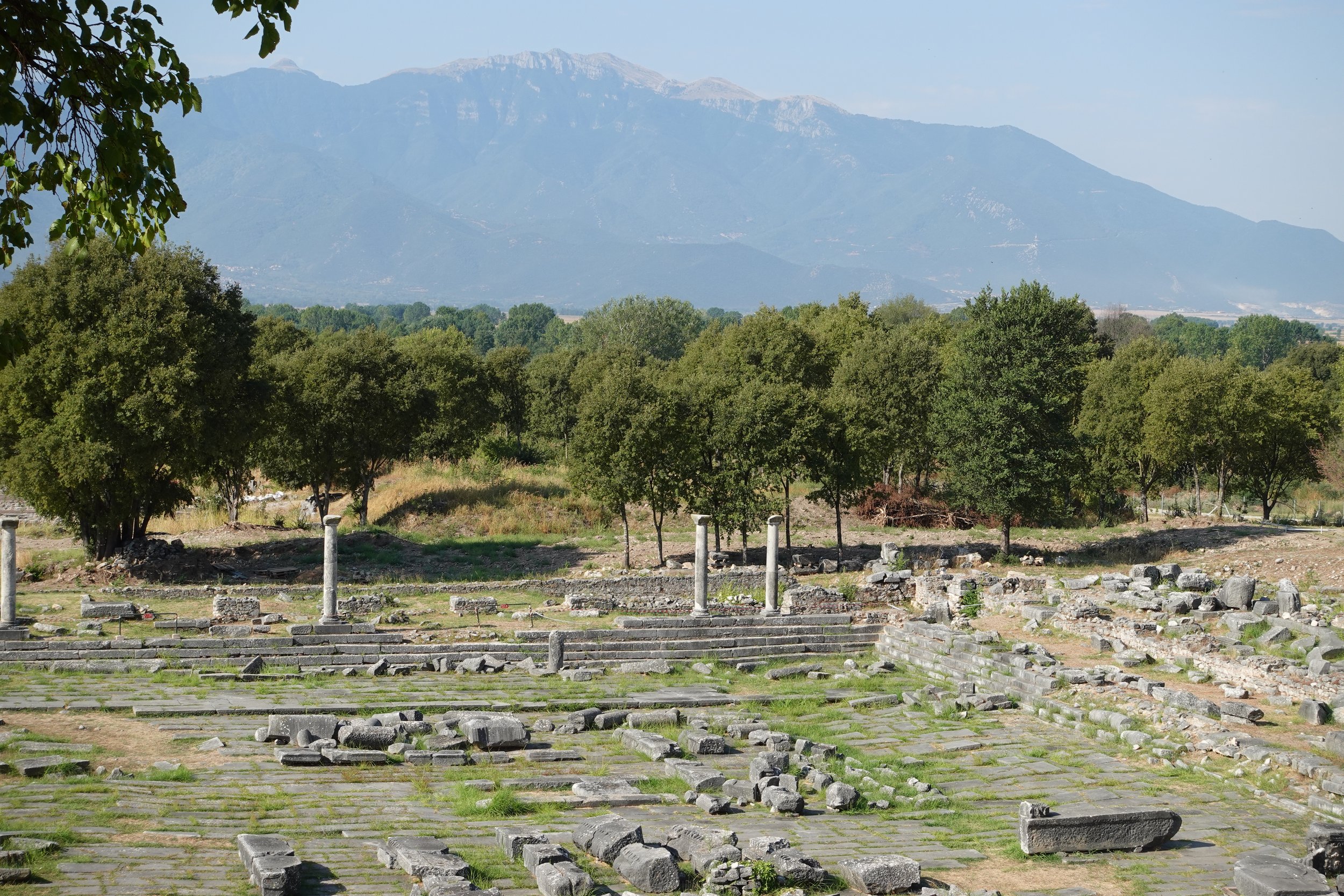Vacation Part 6- Kavala
The rising sun illuminates the port of Kavala, with a tug and tour busses standing by.
For our second morning on the Azamara Quest, we enjoyed breakfast while watching the ship come along side in the little harbor of Kavala, Greece. With the mooring complete, we were sent down the gangway for a tour of Phillipi and the first stop in our unintended week-long journey in the steps of Saint Paul.
The modern city of Kavala is built on the ruins of the Byzantine city of Christopoulus, which was renamed from the original Greek Neapolis . Enroute to the ruins of Philipi, we passed through a mix of old and new. Modern buildings stood shoulder to shoulder with the 500 year old St. Nicholas Orthodox Church, and an aqueduct that was older than that. Our bus then paralleled the Roman military road, Via Egnatia, that connected the port to the inland city of Philipi via a saddle in the mountains.
The aqueduct snaking through town on its way to the fortifications built on the old Greek Acropolis. (More on that later.)
The walled city of Philippi is located in a fertile valley north of the coastal mountain range about nine miles from Kavala. It came to prominence in 356BC when the Macedonian King Philip II took over the town, renamed it for himself, and exploited the gold and silver deposits in the nearby mountains. The Romans moved in after they conquered Macedonia in 168 BC. In 42 BC, Brutus and Cassius, famous assassins of Julius Caesar, lost their battle with Mark Antony and Octavian on the nearby farm fields in the Battle of Philippi, basically ending the Roman Republic. With that colorful backdrop, the “Little Rome” of the east was a flourishing agriculture and trade city when Saint Paul walked over the hill from Neapolis in 49AD. He must have been a pretty convincing character, because Christianity flourished in the valley and several churches and a basilica were built in the city.
The overhead image of the ruins shows the basic shape of the city with the wall anchored by a fort on the hill to the north.
Every Roman city has a Forum, or as our Greek guide said, “we prefer to say Agora.”
Because a chapel dedicated to Saint Paul’s imprisonment was built over this dugout cistern, it is believed this is where he was held during his visit to Philipi. Like most of the structures in Phillipi, the chapel was probably destroyed by earthquakes.
A better view of the interior.
Among the ongoing excavations is this octagonal church with a mosaic floor.
There is an inscription in the tiles dedicating the church to Paul.
The original theater is still hosting performances today.
Following our visit to Philippi, we were taken to a small octagonal Orthodox Chapel, next to a small river, where the small Jewish population of Roman Philippi is said to have spent their Sabbaths. Paul did much of his teaching by rivers and it is was at this spot that he is believed to have baptized Lydia, making her’s the first baptism in Europe. As you can imagine, The Baptistry of Saint Lydia is still a very popular place to conduct that particular sacrament.
Our guide giving us the run-down on Saint Paul and the baptism of Lydia at this very spot.
On the way back to the ship, (visible in the harbor) the guide had the bus stop at an overlook for a view of a preserved section of the original Roman road ascending from the city. The road is now a public park turned ‘urban outdoorsman’ camp.
Our tour of Philippi and the Baptistry only took about four hours, so when we got back at the ship we grabbed a quick lunch and our guide book for an afternoon on foot. Our route took us back into the city center, under the aqueduct, and then sharply up hill to the original acropolis turned fortification. After exploring the top, we made our way back down via the cliff-side path and stairs to the harbor below, enjoying the breeze and unobstructed view of the Aegean sea.
The aqueduct, known as the “Kamares” or “Arches”. It was rebuilt by the Ottomans to supply water to the fortifications.
Because the acropolis has been a defensive structure since before the Romans arrived, there are archeological excavations everywhere. The round tower is Byzantine and survived the Ottoman razing of the town in 1391, but current walls date to the 1530s when Suleiman the Magnificent (remember him from Istanbul?) reinforced his coastal holdings.
The acropolis has a commanding view of the harbor. The old fort now hosts a concert venue and a cafe.
The cliff-side path had several switch-backs leading to the “beach” below.
The rocks are much bigger than they appear.
One last set of stairs and it is back to the ship for a swim before dinner.


















